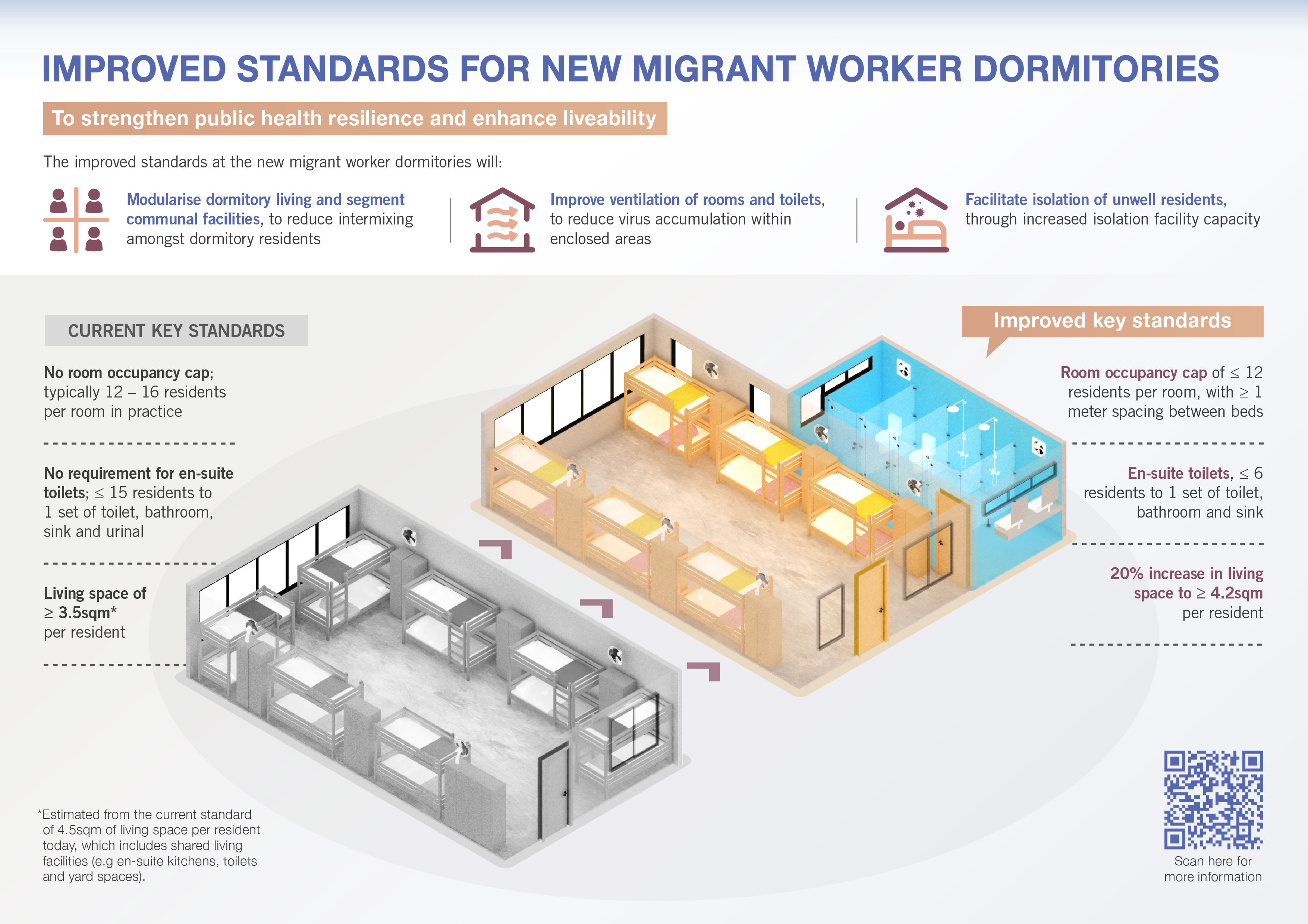Larger living spaces, en-suite toilets among improved standards for all new migrant worker dormitories
The improved standards will "strengthen resilience" against future pandemics, said the Manpower Ministry. More than 50,000 COVID-19 cases have been recorded in dormitories in Singapore since the start of the COVID-19 outbreak.
SINGAPORE: All new migrant worker dormitories will have to meet improved standards so as to "strengthen resilience" against future pandemics and "enhance liveability", the Ministry of Manpower (MOM) said on Friday (Sep 17).
These standards were developed by MOM, the Ministry of National Development (MND) and the Ministry of Health (MOH), in consultation with non-governmental organisations, architects, dormitory operators, employers and migrant workers, after COVID-19 infected tens of thousands of migrant workers living in dormitories.
More than 50,000 COVID-19 cases in Singapore were recorded in dormitories since the start of the pandemic.
The new standards include modular living, more spacious rooms, better ventilation in rooms and toilets and better early detection and isolation of unwell residents.
MOM and MND announced some of these plans for new foreign worker dormitories last year, as part of efforts to reduce density in the dormitories.
"The COVID-19 pandemic has highlighted the importance of strengthening the resilience of our migrant worker dormitories, which house many workers in our land-scarce Singapore," Manpower Minister Tan See Leng told reporters on Friday.
"One of the key learnings from this outbreak in the dormitories last year is that as dormitories are designed for communal living, it makes them more susceptible to transmissible infectious diseases."
As such, the Government has looked into areas to improve the standards to "strengthen the resilience" of the dormitories.
He acknowledged that the improved standards "may result in higher costs" as future dormitories may be more expensive to build and operate.
"However, prevention is always better than cure, especially as we've seen the potentially grave implications of a disease outbreak on migrant workers, employers in Singapore's economy," he said.
MORE SPACIOUS ROOMS, BETTER VENTILATION
New dormitories will be modular, with rooms outfitted with en-suite toilets. The rooms will be more spacious, with at least 4.2 sqm of living space per resident, up from 3.5 sqm, with beds spaced at least 1m apart.
All rooms will have Wi-Fi coverage and occupancy will be capped at 12. There was previously no cap on the number of residents per room, although most rooms had 12 to 16 residents "in practice", said MOM.
Communal facilities, such as cooking, dining and laundry facilities, will now be segmented, with each section serving no more than 120 residents. There will be a limit of 240 residents per floor.
In addition, there will be at least one set of en-suite toilet, bathroom and sink per six residents, up from one set of common or en-suite toilet, bathroom, sink and urinal per 15 residents.
Dormitory rooms and toilets will be better ventilated, and each toilet must have at least one exhaust. There must also be an "adequate number" of fans, reasonably spaced out throughout the room, to provide sufficient air circulation, said MOM.
Previously, ventilation was subjected to the Building and Construction Authority’s prevailing requirements for natural ventilation, such as requiring windows or openings to be at least five per cent of the floor area of the room.

The Government will also improve early detection and quick isolation of unwell residents, with increased capacities at isolation facilities and requirements to carry out wastewater surveillance.
New dormitories will have at least 10 isolation beds per 1,000 bed spaces, compared to the current ratio of one isolation bed to 1,000 bed spaces.
An additional 15 isolation beds per 1,000 bed spaces need to be stood up during pandemics, said MOM.
There must also be a minimum of one power socket per sleeping area, and a "sufficient number" of power sockets in common areas is encouraged. There is currently no requirement for power sockets.
Dormitories with 50 to 1,000 beds must now provide outdoor recreational spaces, the area depending on the size of the dormitory. Currently, only dormitories with more than 1,000 residents are required to provide such spaces.
In addition, there needs to be one set of recreational facilities per 5,000 residents.
The new standards will apply to all new dormitories, including purpose-built dormitories, factory-converted dormitories, construction temporary quarters and temporary occupation licence quarters.
They will also apply to all new applications submitted on or after Saturday to relevant Government agencies for clearance to develop a dormitory.
"For existing dormitories, we are reviewing the improvements that are feasible within current built infrastructure constraints," said MOM.
ENFORCEMENT
To ensure that dormitory operators follow the improved standards, the Government will incorporate the improved standards into the Foreign Employees Dormitories Act licence conditions, which regulate operators of dormitories.
The standards will also be included in other relevant legislation and guidelines, said MOM. It adds that operators will have to seek in-principle approval from the appropriate agencies before being allowed to start construction.
SITES AT KRANJI AND JALAN TUKANG
Two new purpose-built dormitories will be launched at Kranji and Jalan Tukang, to be completed in the next three years.
Together, they will provide at least 12,500 beds - the Kranji site will have at least 10,000 beds, while the Jalan Tukang site in Jurong will have about 2,500 beds.
They will be constructed on land that have "no competing uses" and with "largely ready infrastructure" such as water and roads, said MOM. The sites are in industrial estates.
“To ensure the timely construction of (purpose-built dormitory) beds in the current economic climate, the Government will construct and own these dormitories, while the day-to-day operations will be managed by a dormitory operator,” said MOM in its press release.
“Given our limited land area, some dormitories may have to be located closer to residential areas. We hope that Singaporeans will continue to give their support to these workers who build and maintain our homes and public spaces.”
BOOKMARK THIS: Our comprehensive coverage of the COVID-19 pandemic and its developments
Download our app or subscribe to our Telegram channel for the latest updates on the coronavirus pandemic: https://cna.asia/telegram
















